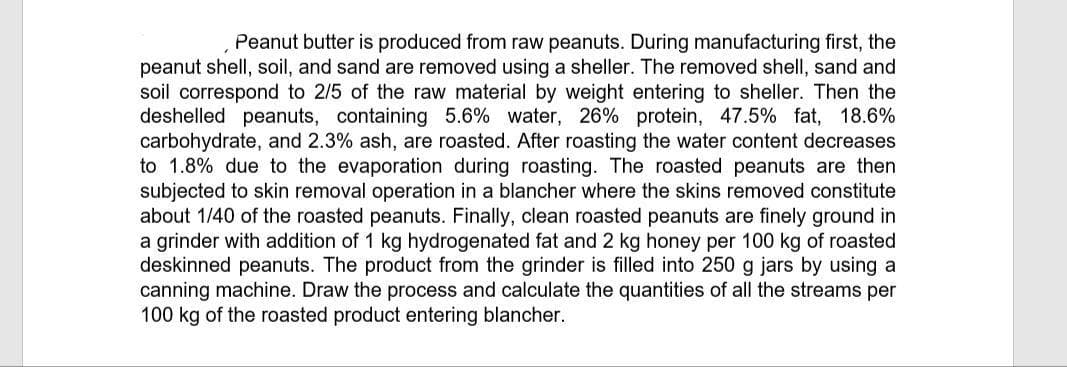Peanut butter is produced from raw peanuts. During manufacturing first, the peanut shell, soil, and sand are removed using a sheller. The removed shell, sand and soil correspond to 2/5 of the raw material by weight entering to sheller. Then the deshelled peanuts, containing 5.6% water, 26% protein, 47.5% fat, 18.6% carbohydrate, and 2.3% ash, are roasted. After roasting the water content decreases to 1.8% due to the evaporation during roasting. The roasted peanuts are then subjected to skin removal operation in a blancher where the skins removed constitute about 1/40 of the roasted peanuts. Finally, clean roasted peanuts are finely ground in a grinder with addition of 1 kg hydrogenated fat and 2 kg honey per 100 kg of roasted deskinned peanuts. The product from the grinder is filled into 250 g jars by using a canning machine. Draw the process and calculate the quantities of all the streams per 100 kg of the roasted product entering blancher.
Optimization
Optimization comes from the same root as "optimal". "Optimal" means the highest. When you do the optimization process, that is when you are "making it best" to maximize everything and to achieve optimal results, a set of parameters is the base for the selection of the best element for a given system.
Integration
Integration means to sum the things. In mathematics, it is the branch of Calculus which is used to find the area under the curve. The operation subtraction is the inverse of addition, division is the inverse of multiplication. In the same way, integration and differentiation are inverse operators. Differential equations give a relation between a function and its derivative.
Application of Integration
In mathematics, the process of integration is used to compute complex area related problems. With the application of integration, solving area related problems, whether they are a curve, or a curve between lines, can be done easily.
Volume
In mathematics, we describe the term volume as a quantity that can express the total space that an object occupies at any point in time. Usually, volumes can only be calculated for 3-dimensional objects. By 3-dimensional or 3D objects, we mean objects that have length, breadth, and height (or depth).
Area
Area refers to the amount of space a figure encloses and the number of square units that cover a shape. It is two-dimensional and is measured in square units.

Step by step
Solved in 2 steps with 2 images




